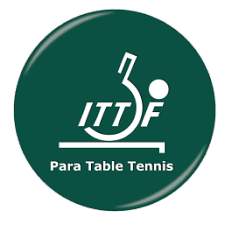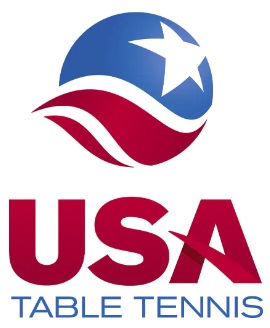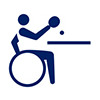 a Summer Games Paralympic Sport
a Summer Games Paralympic SportGoverning Bodies
International Governing Bodies

International Table Tennis Federation (ITTF)

ITTF Para Table Tennis (IPTTC)
National Governing Bodies
United States

USA Table Tennis
ITTF Para Table Tennis Ranking Lists
Introduction:
Para table tennis is a parasports which follows the rules set by the International Table Tennis Federation (ITTF). The usual table tennis rules are in effect with slight modifications for wheelchair athletes. Athletes from disability groups can take part. Athletes receive classifications between 1-11. Classes 1-5 are for those in wheelchairs and classes 6-10 for those who have disabilities that allow them to play standing. Within those groups, the higher classification means the more function the athlete has. Class 11 is defined for players with an intellectual disability.
History of the Sport:
Para table tennis has been part of the Paralympic program since the first Games were held in Rome in 1960, when only wheelchair athletes competed. Interestingly, table tennis has a much longer history in the Paralympic Games than its Olympic counterpart, which first appeared in 1988. Today, table tennis is the third largest Paralympic sport in terms of athlete numbers.
Like all other para sports, table tennis was open only to athletes in wheelchairs from when the Games began in 1960 up until the 1976 Games. Today, this sport is played by athletes with a wide range of impairments, who are classified into 11 classes based on their physical and intellectual impairments for Paralympic competitions. This age-old sport has more than 40 million competitive players in over 100 countries worldwide.
In 2007, the governance for para table tennis was transferred from the International Paralympic Committee to the ITTF. In February 2008, the ITTF announced several rules changes after an ITTF Executive Meeting in Guangzhou, Guangdong, China with regards to a player’s eligibility to play for a new association. The new ruling was to encourage associations to develop their own players.
Rules – How to Play the Sport:
Classification:
The roles of classification are to determine eligibility to compete for athletes with disability and to group athletes equitably for competition purposes. Athletes are grouped by reference to functional ability, resulting from their impairment.
Sitting classes
- Class 1:
No sitting balance with severe reduction of function in the playing arm. - Class 2:
No sitting balance with reduction of function in the playing arm. - Class 3:
No sitting balance, although the upper part of the trunk may show activity.
Normal arms, although some slight motor losses can be found in the playing hand without significant effect on table tennis skills.
The non-playing arm keeps the trunk in position. - Class 4:
Existing sitting balance although not optimal because of non-existing anchorage (stabilisation) of the pelvis. - Class 5:
Normal function of trunk muscles.
Standing classes
- Class 6:
Severe impairments of legs and arms. - Class 7:
Very severe impairments of legs (poor static and dynamic balance), or
severe to moderate impairments of playing arm, or
combination of arms and legs impairments less severe than in class 6. - Class 8:
Moderate impairments of the legs, or
moderate impairments of playing arm (considering that elbow and shoulder control is very important), or
moderate cerebral palsy, hemiplegia or diplegia with good playing arm. - Class 9:
Mild impairments of the leg(s), or
mild impairments of playing arm, or
severe impairments of non-playing arm, or
mild cerebral palsy with hemiparesis or monoplegia. - Class 10:
Very mild impairments in legs, or
very mild impairment of playing arm, or
severe to moderate impairment of non-playing arm, or
moderate impairment of the trunk. - Class 11:
For players with an intellectual disability.
There are no exceptions to the laws of table tennis for standing players with a disability. All players play according to the laws and regulations of the ITTF. The umpire may relax the requirements for a correct service if the compliance is prevented by physical disability.
Rules adaptations for players in wheelchairs
The ITTF laws of table tennis include several adaptations for players in wheelchairs, as detailed below:
Wheelchairs
Wheelchairs must have at least two large wheels and one small wheel. If the wheels on the player’s wheelchair become dislodged and the wheelchair has no more than two wheels, then the rally must be stopped immediately and a point awarded to their opponent.
The height of one or maximum two cushions is limited to 15 cm in playing conditions with no other addition to the wheelchair. In team and class events, no part of the body above the knees may be attached to the chair as this could improve balance.
Serving
The umpire may relax the requirements for a correct service if he or she is satisfied that compliance is prevented by a physical disability. This will always be done for Class 1 B C D A Page 16 and Class 2 players (refer Appendix H). The player’s international classification card contains a section indicating any physical limitations that the player may have affecting compliance with the requirements of a correct service e.g. where a player with a disability is either not able to straighten his or her palm or does not have a hand, the player may serve with a curved palm or toss the ball from his or her stump.
Receiving
If the receiver is in a wheelchair due to a physical disability, the rally is a let if the ball comes to rest on the receiver’s court, or after touching the receiver’s court returns in the direction of the net, or, in singles, leaves the receiver’s court after touching it by either of the sidelines. This is because a player in a wheelchair, by definition, is restricted in the extent of his or her ability to stretch and a service returning towards the net or going out from the sidelines is regarded as unfair. The ball can cross the sideline after one or more bounces. However, in singles play and where the ball is travelling towards the side line, if the receiver strikes the ball before it crosses a sideline or takes a second bounce on his or her side of the playing surface, the service is considered good and no let is called.
The service shall be a let under the following circumstances if the receiver is in a wheelchair:
- After touching the receiver’s court, the ball returns in the direction of the net.
- The ball comes to rest on the receiver’s court.
- In singles, the ball leaves the receiver’s court after touching it by either of its sidelines.
If the receiver strikes the ball before it crosses a sideline or takes a second bounce on his or her side of the playing surface, the service is considered good and no let is called.
Contact with seat and table
A player who is in a wheelchair due a physical disability and who does not maintain a contact with the seat or cushion with the rear side of at least one of the thighs just before striking the ball is considered to be gaining an unfair advantage and the opponent is awarded a point. If a player is in a wheelchair due to a physical disability, he or she may only touch the table with his or her racket hand to restore balance, only after a shot has been played, provided the playing surface does not move. The player is not allowed to use the table as an extra support before striking the ball. Similarly the player may not use his or her free hand on the table as an extra support, or touch the playing surface at any time during the rally. In a doubles match this applies to both players.
Limb positions
If both players or pairs are in a wheelchair, the player or the pair score a point if:
- the opponent does not maintain a minimum contact with the seat or cushion(s), with the back of the thigh, when the ball is struck.
- the opponent touches the table with either hand before striking the ball.
- the opponent’s footrest or foot touches the floor during play.
Medical recovery period
If a player with a disability is unable to play temporarily due to the nature of his/her disability or condition, the referee may, after consulting a medical classifier or doctor at the competition, allow a medical recovery time of the shortest practical duration, but in no circumstances more than 10 minutes.
Doubles play
When a doubles pair comprises two players who are in wheelchairs due to a physical disability, the server first makes a service and the receiver makes a return, but thereafter either player of the disabled pair may make a return. However if any part of a player’s wheelchair protrudes beyond the imaginary extension of the center line of the table, the umpire will award a point to the opposing pair. This also applies when a “mixed” pair (one standing and one wheelchair) are playing together. Either player may return the ball (after initial service and return), but each player has to remain in his or her own half of the court. No part of the player’s wheelchair can cross the imaginary extension of the center line and the standing player cannot put a foot over this line either.


